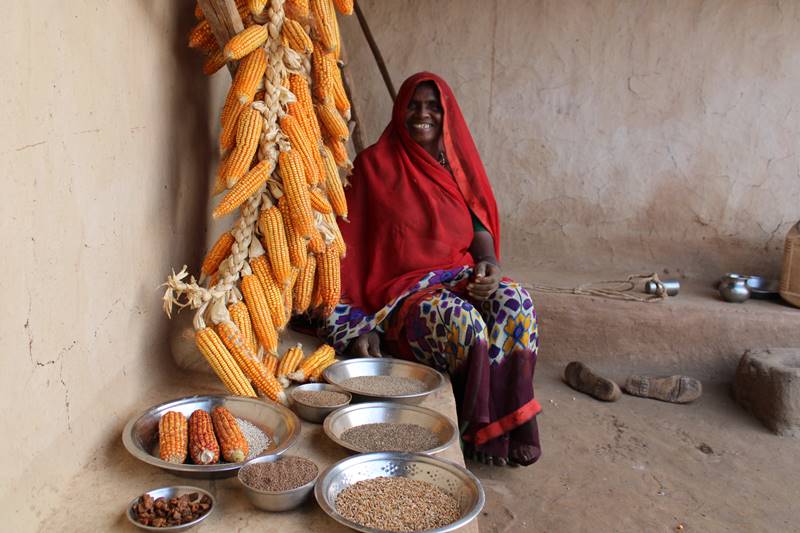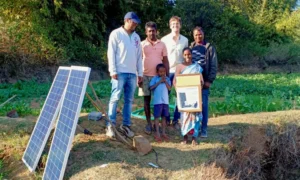Since her childhood, Sukhmanti Devi has saved indigenous seeds. “I started conserving seeds when I was only ten-years-old. My parents were also farmers, and they taught me how important indigenous seeds were for a farmer,” Devi, a resident of Chataniha village, Deosar block, Singrauli district of Madhya Pradesh told Gaon Connection.
It’s been nearly four decades since 47-year-old Devi began conserving seeds indigenous to her land. And so far, she has conserved more than 40 varieties of seeds. These include makka (maize), dhan (paddy), sawan (barnyard) millets. “I have five to six varieties each of makka, dhan and tilhan (oilseeds). I collect them, use some for cultivation, and store them after harvesting for the new season,” she explained.
But what makes her story unique?
“There are at least five hundred households in Chataniha village. Most of the farming households are either using hybrid seeds or both indigenous and hybrid varieties. But Devi’s is the only household focussing solely on indigenous varieties,” Jyotsana Jaiswal, member PRADAN [Professional Assistance for Development Action], a non-profit working to reduce poverty and transforming lives of poorest communities of rural India, told Gaon Connection.
“Everyone gets into buying hybrid seeds and increasing income without knowing facts about the terrain and resources of their village. However, Devi understands her land, resources, and the importance of desi seeds for slopes,” added Jaiswal.
Of the total five acres [two hectares] of Devi’s field, PRADAN has helped create a farm terrace in one acre. “In hill areas, terracing is the way farming happens. The only problem with this is that soil can get washed down when it rains or the fields are irrigated,” Jaiswal said. But, she explained that with Devi’s farm terrace this would not happen. To contain and bind soil, a border row was created using fast growing plants such as bamboo and lettuce, she said.
So far, PRADAN has set up at least 15 such farm terraces in the Deosar block.
Also Read: This ‘seed woman’ never went to school, but has valuable lessons for us and the farmers
Farming in slopes
The high-yielding hybrid seeds require excess water for cultivation, plain lands, and a lot of money. “I have none of these. Ours is not a plain land. It is difficult to do farming in such terrain. Hybrid seeds need plenty of water and a flat terrain to grow,” said Devi.
“Those who can afford it are buying hybrid seeds. We don’t have money or suitable land or excess water to support such farming. For our crops, we are dependent on rain,” she added.
This is when indigenous crops come to the aid of farmers in the hills.
“Desi beej (indigenous seeds) require less water and can grow in inclined terrain too,” informed Devi, who grows maize, paddy, oilseeds, barley, and vegetables such as brinjals, tomatoes, and chillies, mustard, barvati (cowpea) and alsi (flax seeds).
However, “during Rabi season, we have to fetch water from the nearby river that is two kilometres away from my field. We fill our dabba [10-20 litre bucket] at least five times a day for irrigating vegetables in our field”, she added.
Also Read: About 40% women in rural households work harder to fetch water in the COVID-19 lockdown
Benefits of indigeous seeds
A 2019 research paper titled ‘The impact of the Green Revolution on indigenous crops of India’, shows that the indigenous varieties of rice and millets are resistant to drought, salinity, and floods.
However, post the Green Revolution — initiated in the 1960s by introducing high-yielding varieties of rice and wheat to increase food production to alleviate hunger and poverty — the production of other food crops such as indigenous rice varieties and millets declined.
Also Read: A library for rice with grains from the past
“This led to the loss of distinct indigenous crops from cultivation and also caused extinction. The Green Revolution impacted the production of indigenous crops, environment, nutrition intake, and per capita availability of foods,” read the paper.
“Indigenous seeds require less water as compared to hybrid seeds. These hybrid seeds also affect soil health as they absorb more nutrients from soil. In the slopes, nutrients continue to get lost as the soil gets washed away when it rains. In such cases, indigenous varieties perform better. They have more germination viability even in normal varieties,” Sanjay Singh, Jabalpur based scientist and plant breeder, told Gaon Connection.
“Also, hybrid seeds can be conserved only for one or two years while indigenous can be conserved for two to four years in normal conditions. Kodo Sawan millets can be viable for a hundred years,”, he added.
There are several health benefits too of indigenous crops. For instance, it helps reduce the risk of developing type II diabetes, obesity, and cardiovascular diseases by lowering the glycemic and insulin responses.
Climate resilient seeds
“Indigenous itself means that the seeds were nurtured according to the environment. They are resilient to drought, and pest attack in them is less. The only disadvantage is that their production is less compared to hybrids. But quality gets compromised in hybrid seeds,” said Singh, who is working with the Plant Breeding and Genetic department, Jawaharlal Nehru Krishi Vishwa Vidyalaya, public university in Jabalpur, Madhya Pradesh.
“To sustain ourselves on earth, we need to use indigenous seeds in breeding programmes and genetic improvement programmes and conserve them,” he added.
Using seeds to repay loans
The latest National Statistical Office (NSO) survey, Situation Assessment of Agricultural Households and Land Holdings of Households in Rural India, 2019, shows every second agricultural household in India is in debt.
A survey conducted by Gaon Connection last summer also put forth the hardships faced by the rural households during the COVID19 pandemic. The survey found 20 per cent of the rural respondents had to pledge or sell land, jewellery and valuables in order to tide over the COVID19 lockdown. Another 23 per cent had to borrow money to meet various expenses.
Similar was the story of Devi.
During the second wave of the COVID19 pandemic, Devi’s grandson succumbed to fever. “It was in June that we lost our grandson. We did not even have the money to perform his last rites. We had no other option but to take a loan of three thousand rupees from the baniya (money lender). We also took a loan of five hundred rupees from a local self help group,” Devi said. The latest NSO survey also pointed out that 20.5 per cent of loans were taken from professional money lenders.
Devi plans to repay the loan with the help of her seeds. “These seeds are necessary for our survival. If we do not conserve them, and they become extinct, what would we eat? How would we survive?” she asked?



















